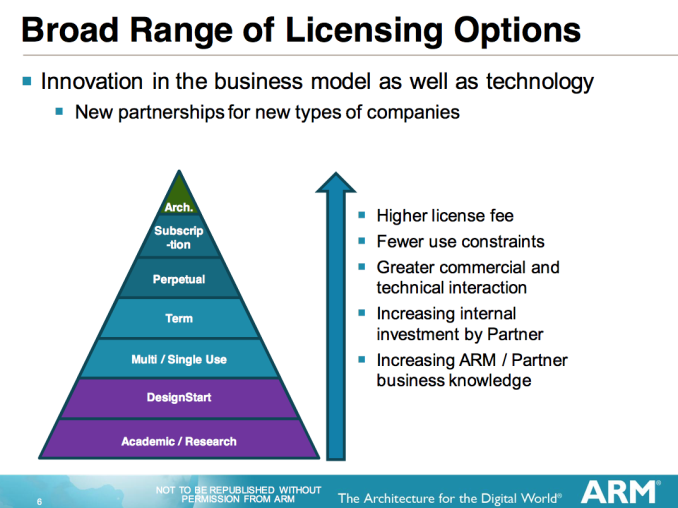The ARM Diaries, Part 1: How ARM’s Business Model Works
by Anand Lal Shimpi on June 28, 2013 12:06 AM ESTTypes of License
Although I wrote about there being three high level license types (processor, POP and architectural) in reality there’s a spectrum of options that ARM offers.
Academic licenses are effectively free. You can’t sell any designs but it’s a great way to build familiarity with an architecture. DesignStart is a low cost option for an academic/research arm of a company. Again, neither of these designs can be sold which is why the up front fee is very low/effectively zero.
ARM offers single use licenses for companies who just need a particular core for a single project (e.g. I want to build a single design based on the Cortex A9). A single use license for a Cortex A-class CPU will be somewhere around $1M up front plus ~2% per chip sold. The single use licenses are really useful for startups or very specific design needs within a company.
Multi-use licenses make a bit more sense for larger companies with multiple products. Here you get a larger up front fee but you can use your licensed CPU design within any number of products within a certain period of time (e.g. 3 years). During that time frame you can design as many products as possible, but you cannot begin any new designs after the 3 year period ends without a license renewal.
Perpetual multi-use licenses are more common in larger companies. These allow the licensee to use a core in any number of devices, indefinitely. As some ARM licensees can keep the same core in use for 10 - 20 years (particularly in industrial applications), the perpetual multi-use license gets a fair bit of use.
The subscription license is quite possibly the most interesting out of the pyramid. Companies can purchase a subscription license to ARM’s entire portfolio of products, for a set number of years. What a subscription license really enables is engineering managers within a company to start a chip project without having to worry about asking for budget for a large up front license fee since the company as a whole has already paid it. The up front fee here is multiple times the $10M top end for a standard part, for obvious reasons.
Finally at the top of the pyramid is an ARM architecture license. Marvell, Apple and Qualcomm are some examples of the 15 companies that have this license.
The Chosen Three
Since ARM doesn’t actually make any chips of its own, it needs to ensure that for each generation there are launch partners that will produce designs based on the latest and greatest. For each new microprocessor IP, ARM chooses up to three partners to work very closely with. The reason for choosing three is to hopefully work with companies targeting multiple markets. We tend to focus on the high-end smartphone/tablet SoC space here, but ARM architectures find their way into industrial, digital home, TV and other markets as well.
These companies get earlier access than any other licensee to whatever new microarchitecture ARM is working on. The licensees in exchange help debug and test the IP, even providing feedback directly to ARM. The benefit to the licensee is the potential for a significant time to market advantage on the new microarchitecture.











64 Comments
View All Comments
pluto7777 - Friday, June 28, 2013 - link
Exactly what is this IP they sell? Is it for hardware or software because Mali is a giant black box. Intel came to realize they could do more good for the end users by embracing open source. It's a shame this idea completely escapes ARM.ShieTar - Friday, June 28, 2013 - link
ARMs main IP is the processor design. Intel has absolutely no plans to make their Haswell-Designs open source. They also still sell their compiler and high performance libraries, so I really don't see how they are "embracing open source". Care to clarify your statement?Spunjji - Friday, June 28, 2013 - link
I'm fairly sure they're talking complete nonsense.name99 - Friday, June 28, 2013 - link
And it's not even Haswell's design. Intel produces a ton of software (like ICC and their math libs) which aren't open source...pluto7777 - Friday, June 28, 2013 - link
True, but it's evident Intel is at least trying. Even AMD has made some positive steps. Do yourselves a favor and look into Lima. ARM apparently doesn't like people reverse engineering their stuff.pluto7777 - Friday, June 28, 2013 - link
Intel has open source drivers on Linux. They actually employee people to work on this instead of other companies who only have closed source drivers and force other people to backwards engineer everything if they want an open driver.iwod - Friday, June 28, 2013 - link
Seeing both IMG ( MIPS ) and ARM are IP liscensing company, do both company's business mode work similary?And When will Anantech do a piece on the newly annoucned MIPS v5 "Warrior".
pluto7777 - Friday, June 28, 2013 - link
That's another true loss. I can't Imagine how anyone could want anything from Imagination Technologies. I hope they only get Microsoft support and don't try to leech off the open source community through some loophole like Android does.munsie - Friday, June 28, 2013 - link
I assume you mean the MIPS processor, not their GPUs? Because Apple has been shipping Imagination Tech GPUs since the first iPhone and Intel used them originally for their integrated graphics.ShieTar - Friday, June 28, 2013 - link
"In the PC industry, the concept of a fabless semiconductor isn’t unusual."And most chemistry labs also work with fabless semiconductors. I think this sentence is missing a word ;-)